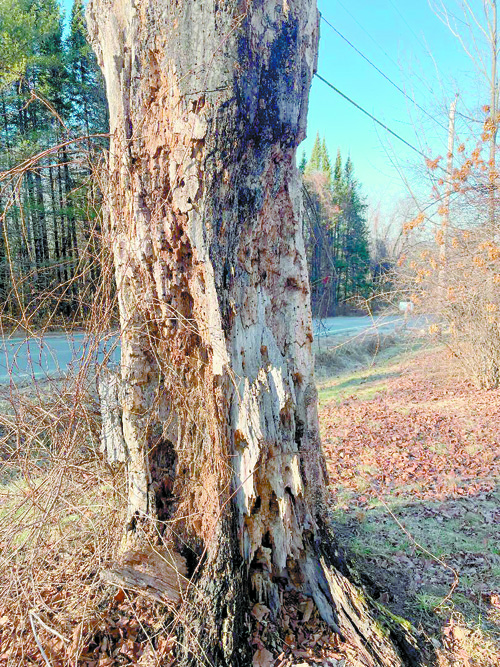Earth Notes — What good is a dead tree?

By Cynthia Stancioff
Guest Columnist
I’ve been appreciating dead trees more and more lately, since they seem to be increasingly under-valued by average property owners. I say: A dead tree is no less important than a live tree!
It seems most people respond to the death of a tree by removing it from sight immediately, as if it’s not a valid entity any more. They “clean up” their wooded plots by removing the dead trees, and pay “tree surgeons” to whisk away dead yard trees swiftly, completely.
Is this just another facet of our modern inability to interact with our mortality? Are we so unacquainted with nature’s cycles these days that we lack a context not just for our own death, but for the death of anything?
I’ve been fascinated to read about just how much is going on in a tree that is dying or dead. Of course, we all have mental cartoon images of woodpeckers mining tree trunks for insects, and raccoons inhabiting hollow large trees. But it’s so much more than that! A dead tree’s beneficiaries can include numerous bird species, mammals, beetles, moths, fungi, centipedes, spiders, mosses, lichens, salamanders, and seedlings.
The meticulous and prolific observer of nature, Bernd Heinrich, summarizes the dead tree situation thus: “As with animal carcasses, a progression of scavengers attacks the carcass, one species after another, until the feeding queue ends and the tree has returned to the soil.” A lot of life can depend on this one death!
Did you know that bird lovers count more than 100 species of bird that rely on dead trees for nesting and/or shelter? Or that many cavities created by one species in tree trunks can be re-purposed by another species, and are sometimes revisited for many years? There used to be a great blue heron rookery straddling a swamp near us. For years, prehistoric looking herons nested only in the tip-tops of towering bare dead trees, probably for visibility and maneuvering reasons.
Some of us value dead elms for hosting the edible dryad’s saddle fungus, dead maples for startling cascades of oyster mushrooms, dying oaks for their hen-of-the woods, and many other trees hosting edible and medicinal fungi. I guess this makes us secondary dead tree beneficiaries (after the fungi).
In his lovely book, Life Everlasting(Mariner Books, 2012), Heinrich relates finding 353 bark beetles in an upstairs window one day in mid-winter when his cabin reached an uncharacteristic 75 degrees. They had emerged from the legs of a table made from a dying white birch tree, having eaten their way to maturity from their origin as eggs laid deep in the wood by their parents.
Many species of beetle and wasp drill small holes in dead wood for their eggs in this fashion, often introducing fungal spores at the same time. Hidden mushroom mycelia proceed to rot the inner wood; birds can then create larger cavities used by warm-blooded animals, such as flying squirrels and chickadees, for winter shelters. Did you know hairy and downy woodpeckers create winter homes in rotting stumps? I’m determined to find one of these this winter!
Heinrich notes that a fallen dead tree continues to add value to its neighborhood. It will host mosses, then seedlings that gain an advantage over others by being above the forest leaf litter. Meanwhile, the damp, decaying log shelters insects, toads, salamanders, and others. Ultimately, its wood returns to the soil to build humus and support the future of the ecosystem.
A living tree performs a whole lot of valuable services for the ecosystem; but a little research uncovers the secret life of a dying/dead tree: and another world of value is revealed.
Cynthia Stancioff lives, wanders, and writes in Chesterville, Maine.

